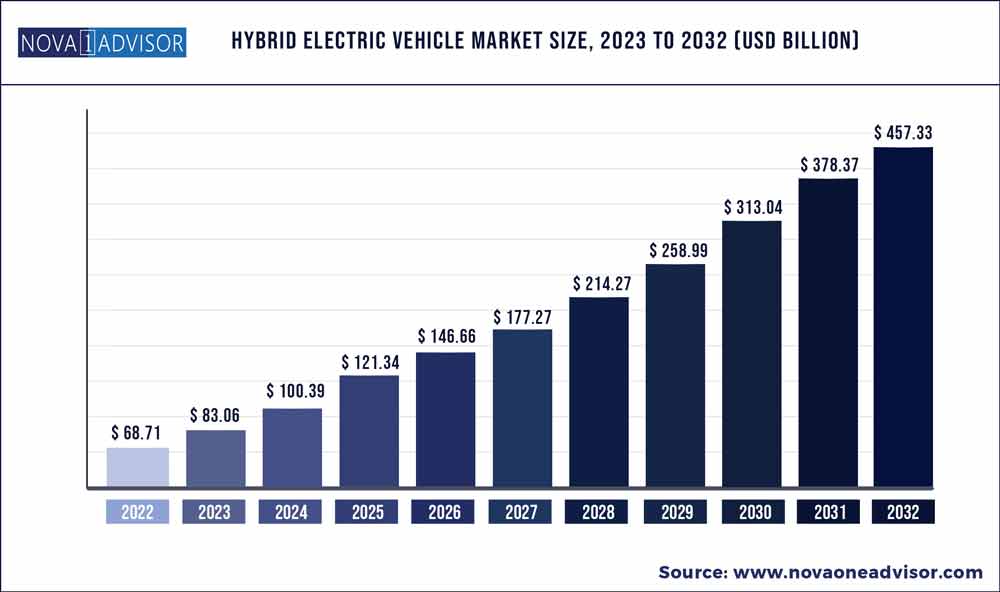The global hybrid electric vehicle market size was exhibited at USD 68.71 billion in 2022 and is projected to hit around USD 457.33 billion by 2032, growing at a CAGR of 20.87% during the forecast period 2023 to 2032.

Key Pointers:
- Gasoline hybrid vehicles projected to surpass a value of over US$ 145 million by 2032
- Stored electricity HEVs is growing at a CAGR of 5.6% from 2023 to 2032
- U.S hybrid electric vehicle is expected to grow at a CAGR of 7.6% through 2032
- Asia Pacific region had garnered revenue share of around 42.50% in 2022
- In 2022, the European region accounted 20.09% revenue share
Hybrid Electric Vehicle Market Report Scope
|
Report Coverage
|
Details
|
|
Market Size in 2023
|
USD 83.06 Billion
|
|
Market Size by 2032
|
USD 457.33 Billion
|
|
Growth Rate From 2023 to 2032
|
CAGR of 20.87%
|
|
Base Year
|
2022
|
|
Forecast Period
|
2023 to 2032
|
|
Segments Covered
|
Type, Application, Power Source, Powertrain, Vehicle
|
|
Market Analysis (Terms Used)
|
Value (US$ Million/Billion) or (Volume/Units)
|
|
Regional Scope
|
North America; Europe; Asia Pacific; Central and South America; the Middle East and Africa
|
|
Key Companies Profiled
|
ZF, Delphi, BorgWarner, Continenta, Schaeffler, Ford, Toyota, Continental, Volvo, Honda, Hyundai, Daimler, Nissan
|
A hybrid electric vehicle (HEV) is an automobile powered by a combination of an internal combustion engine (ICE) and an electric motor. It relies on energy stored in batteries for functioning and regenerative braking, which changes the kinetic energy produced into electric energy. It has less fuel consumption, carbon-based emissions, and maintenance costs than vehicles solely powered by an ICE. As a result, it is gaining immense traction as an environment-friendly alternative to conventional vehicles.
Market Dynamics
Driver: Increasing emission norms
Growing awareness of the emissions has led the regulatory bodies to implement stringent emission regulations. The rising stringency in emission norms for vehicles is forcing OEMs to manufacture hybrid and electric vehicles. Hybrid vehicles emit fewer greenhouse gases than gasoline and diesel vehicles.
The governments in the US and Europe are concentrating on lowering emission limits to decrease the greenhouse gas effect and are also focusing on improving the fuel economy of vehicles. For instance, the US Department of Transportation has set the Corporate Average Fuel Economy (CAFE) standards for vehicles.
Restraint: Rising demand for BEVs and FCEVs
The increasing demand for Battery Electric Vehicles (BEVs) and Fuel Cell Electric Vehicles (FCEVs) will be one of the major challenges for the growth of hybrid vehicles. There are many models and types of BEVs such as hatchbacks, sedans, and SUVs in the passenger car segment. Automotive manufacturers such as BYD (China), Tesla (US), and Volkswagen (Germany) are focusing more on the development of BEVs.
The advantages of FCEVs is a high driving range, fast refueling, noiseless operation, and zero-emission of greenhouse gases and air pollutants. These benefits are positively impacting the demand for FCEVs. Moreover, governments are taking initiatives and promoting fuel cells for transportation, which can further boost the demand for fuel cells in the automotive and transportation sectors. For instance, the government of California launched the Clean Vehicle Rebate Project. The project includes rebate funding for low-income consumers and rebates for the purchase or lease of FCEVs.
Opportunity: Growth in developing markets
Hybrid vehicles offer immense opportunities for growth in the markets of developing countries because of initiatives and support from governments (e.g., incentives in sales and manufacturing, tax rebates, increased focus on deploying hybrid commercial vehicles). The Indian government is providing incentives of approximately USD 446 on the purchase of hybrid and electric vehicles in India. The Brazilian government is encouraging the purchase of hybrid vehicles such as plug-in hybrid, hybrid electric, and CNG hybrid by reducing the tax rate. The Mumbai Metropolitan Region Development Authority (MMRDA), India, has awarded a contract to Tata Motors for supplying 25 Tata Starbus Diesel Series Hybrid Electric Buses.
Challenges: High vehicle cost
The challenge faced by the hybrid vehicle market is high cost. A hybrid vehicle such as a plug-in hybrid vehicle has the battery as its central component. The battery increases the cost of the vehicle, making it costlier than diesel- and gasoline-powered vehicles. The price difference is due to parts such as battery and regenerative brake price. However, there has been a significant decrease in the cost of batteries in the past few years. Also, battery manufacturers are taking initiatives and carrying out R&D operations to decrease the cost of batteries.
Some of the prominent players in the Hybrid Electric Vehicle Market include:
- ZF
- Delphi
- BorgWarner
- Continenta
- Schaeffler
- Ford
- Toyota
- Continental
- Volvo
- Honda
- Hyundai
- Daimler
- Nissan
Segments Covered in the Report
This report forecasts revenue growth at global, regional, and country levels and provides an analysis of the latest industry trends in each of the sub-segments from 2018 to 2032. For this study, Nova one advisor, Inc. has segmented the global Hybrid Electric Vehicle market.
By Type
- Full Hybrids
- Mild Hybrids
- Plug-in Hybrids
- Others
By Application
- Battery
- Electric Motor
- Transmission
By Power Source
- Stored Electricity HEVs
- On-Board Electric Generator HEVs
By Powertrain
- Series Hybrid Electric Vehicles
- Parallel Hybrid Electric Vehicles
- Combined Hybrid Electric Vehicles
By Vehicle
- Hybrid Electric Passenger Cars
- Commercial Hybrid Electric Vehicles
- Hybrid Electric Two Wheelers
- Other HEVs (Golf Cart, etc.)
By Region
- North America
- Europe
- Asia-Pacific
- Latin America
- Middle East & Africa (MEA)

